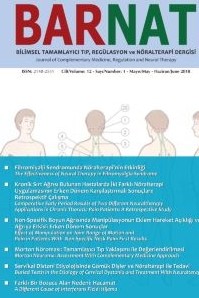TEMPOROMANDİBULAR EKLEM DİSFONKSİYONU BULUNAN YÜKSEK STRES SEVİYESİNE SAHİP HASTALARDA PARAFONKSİYONEL ALIŞKANLIKLARININ DEĞERLENDİRİLMESİ: ÖN ÇALIŞMA
Temporomandibular eklem disfonksiyonu (TMD), orofasiyal bölgede dental kaynaklı olmayan ağrıların başlıca sebebi olup toplumsal
sağlık açısından büyük önem taşımaktadır. Emosyonel stres, gama efferent aktivitesinde artış ile çiğneme kaslarında hipertonusa ve
çeşitli parafonksiyonel alışkanlıklara yol açabilmektedir. Parafonksiyonel alışkanlıklar; hastalarda TMD semptomlarının görülmesine
neden olabilmektedir. Bu çalışmada; yüksek stres seviyesine sahip TMD’li hastalarda parafonksiyonel alışkanlıkların görülme sıklığının
ve bu alışkanlıkların TMD’nin alt tanı grupları ile ilişkisinin incelenmesi amaçlanmıştır. Çalışmaya yaşları 19-57 arasında değişen
15 hasta dahil edilmiştir. Çalışmaya dahil edilen hastaların %67’sinde parafonksiyonel alışkanlığın bulunduğu ve bu hastaların da
%70’inin miyalji tanısına sahip olduğu kaydedilmiştir. Sonuç olarak parafonksiyonel alışkanlığa sahip çiğneme kas miyaljisi bulunan
hastaların tedavi planlamasına diğer tedavi metotlarına ek olarak bilişsel davranışçı terapi yöntemlerinin dahil edilmesi hem hastaların
stresle başa çıkmaları ve hem de ağrı durumlarını kontrol edebilmeleri açısından önem taşımaktadır.
Anahtar Kelimeler:
parafonksiyonel alışkanlık, Miyalji, temporomandibular eklem disfonksiyonu
EVALUATION OF PARAFUNCTIONAL HABITS IN PATIENTS WITH HIGH STRESS LEVEL AND TEMPOROMANDIBULAR JOINT DYSFUNCTION: PRELIMINARY STUDY
Temporomandibular joint dysfunction (TMD) is the major cause of non-dental pain in the orofacial region which is of great importance
for social health. Emotional stress can lead to hypertonus in masticatory muscles and various parafunctional habits via an
increase in gamma efferent activity. Parafunctional habits can be held responsible for the occurrence of TMD symptoms in patients.
This study aims to evaluate the frequency of parafunctional habits in patients with TMDs that had also high stress levels and the relationship
of these habits with TMD sub-diagnosis. 15 patients aged between 19-57 were included in the study. 67% of the included
patients had parafunctional habits and 70% of these patients had diagnosis of myalgia. In conclusion, the incorporation of cognitive
behavioral therapy methods in addition to other treatment modalities is of important for patients who have myalgia diagnosis with
parafunctional habits to cope with stress and manage their pain.
___
- 1. Fernandes G, Goncalves DAG, Conti P. Musculoskeletal disorders. Dental clinics of North America 2018;62:553-564. 2. Okeson JP. Orofacial pain: Guidelines for assessment diagnosis and management. (1.Baskı). ABD: Quintessence Yayınevi, 113-184. 3. McNeill C. Management of temporomandibular disorders: concepts and controversies. The Journal of prosthetic dentistry 1997;77:510-522. 4. Suvinen TI, Reade PC, Kemppainen P, Kononen M, Dworkin SF. Review of aetiological concepts of temporomandibular pain disorders: towards a biopsychosocial model for integration of physical disorder factors with psychological and psychosocial illness impact factors. European journal of pain 2005;9:613-633. 5. Okeson JP. Management of temporomandibular disorders and occlusion. (6.Baskı). ABD: Mosby Yayınevi, 27-31, 149-152, 170-173. 6. Poveda Roda R, Bagan JV, Diaz Fernandez JM, Hernandez Bazan S, Jimenez Soriano Y. Review of temporomandibular joint pathology. Part I: classification, epidemiology and risk factors. Medicina oral, patologia oral y cirugia bucal 2007;12:E292-298. 7. Arntz A, Dreessen L, De Jong P. The influence of anxiety on pain: attentional and attributional mediators. Pain 1994;56:307-314. 8. Erdoğ Özgür M. AÖ, Karabekmez D. Bruksizm teşhis ve tedavisi üzerine güncel yaklaşımlar: Derleme. Turkish Journal of Clinics and Laboratory 2019;10:251-258. 9. Schiffman E, Ohrbach R, Truelove E, Look J, Anderson G, Goulet JP, et al. Diagnostic Criteria for Temporomandibular Disorders (DC/TMD) for Clinical and Research Applications: recommendations of the International RDC/TMD Consortium Network and Orofacial Pain Special Interest Groupdagger. Journal of oral & facial pain and headache 2014;28:6-27. 10. Sharav Y, Banoliel R. Orofacial pain and headache. (1.Baskı) Kanada: Elsevier Mosby Yayınevi, 60-70, 111-113. 11. Slade GD, Bair E, Greenspan JD, Dubner R, Fillingim RB, Diatchenko L, et al. Signs and symptoms of first-onset TMD and sociodemographic predictors of its development: the OPPERA prospective cohort study. The journal of pain : official journal of the American Pain Society 2013;14:T20-32 e21-23. 12. Goulet JP, Velly AM. Orofacial Pain Biomarkers. (1.Baskı) Kanada: Springer Yayınevi, 3- 20.
- ISSN: 2148-2551
- Başlangıç: 2006
- Yayıncı: Bilimsel Nöralterapi ve Regülasyon Derneği
